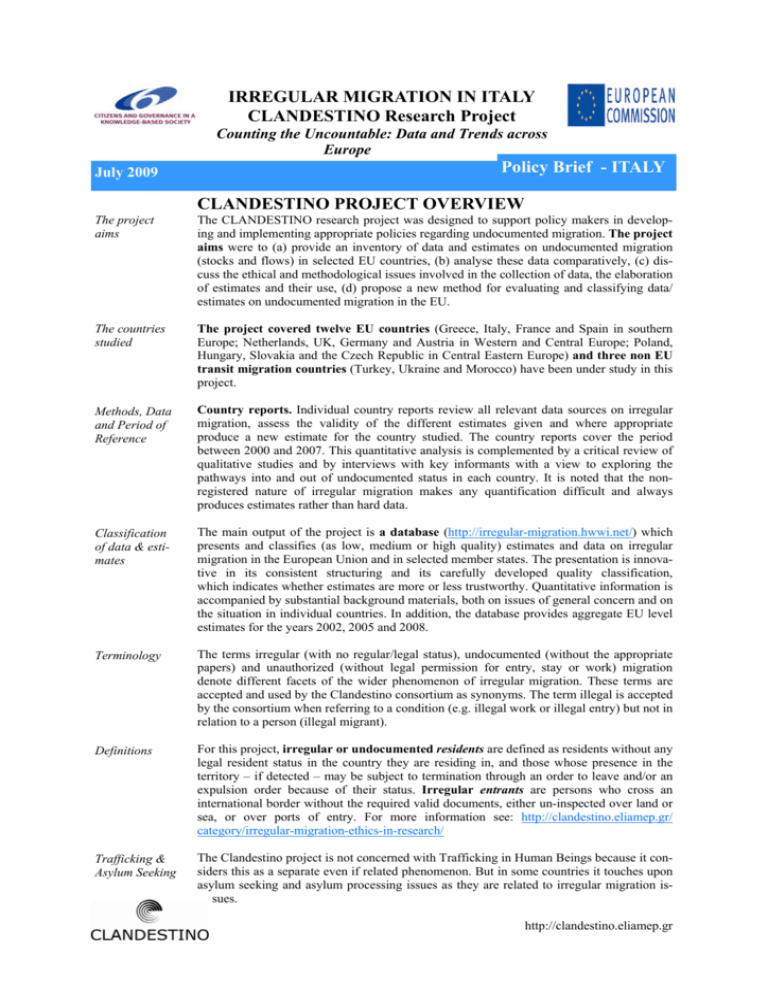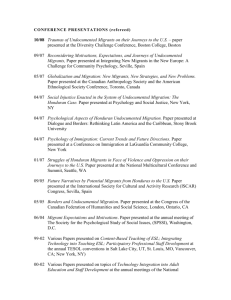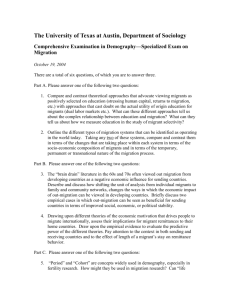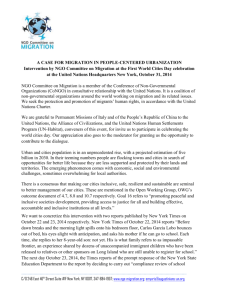ITALY Policy Brief_July 09 - Irregular
advertisement

IRREGULAR MIGRATION IN ITALY CLANDESTINO Research Project Counting the Uncountable: Data and Trends across Europe July 2009 Policy Brief - ITALY CLANDESTINO PROJECT OVERVIEW The project aims The CLANDESTINO research project was designed to support policy makers in developing and implementing appropriate policies regarding undocumented migration. The project aims were to (a) provide an inventory of data and estimates on undocumented migration (stocks and flows) in selected EU countries, (b) analyse these data comparatively, (c) discuss the ethical and methodological issues involved in the collection of data, the elaboration of estimates and their use, (d) propose a new method for evaluating and classifying data/ estimates on undocumented migration in the EU. The countries studied The project covered twelve EU countries (Greece, Italy, France and Spain in southern Europe; Netherlands, UK, Germany and Austria in Western and Central Europe; Poland, Hungary, Slovakia and the Czech Republic in Central Eastern Europe) and three non EU transit migration countries (Turkey, Ukraine and Morocco) have been under study in this project. Methods, Data and Period of Reference Country reports. Individual country reports review all relevant data sources on irregular migration, assess the validity of the different estimates given and where appropriate produce a new estimate for the country studied. The country reports cover the period between 2000 and 2007. This quantitative analysis is complemented by a critical review of qualitative studies and by interviews with key informants with a view to exploring the pathways into and out of undocumented status in each country. It is noted that the nonregistered nature of irregular migration makes any quantification difficult and always produces estimates rather than hard data. Classification of data & estimates The main output of the project is a database (http://irregular-migration.hwwi.net/) which presents and classifies (as low, medium or high quality) estimates and data on irregular migration in the European Union and in selected member states. The presentation is innovative in its consistent structuring and its carefully developed quality classification, which indicates whether estimates are more or less trustworthy. Quantitative information is accompanied by substantial background materials, both on issues of general concern and on the situation in individual countries. In addition, the database provides aggregate EU level estimates for the years 2002, 2005 and 2008. Terminology The terms irregular (with no regular/legal status), undocumented (without the appropriate papers) and unauthorized (without legal permission for entry, stay or work) migration denote different facets of the wider phenomenon of irregular migration. These terms are accepted and used by the Clandestino consortium as synonyms. The term illegal is accepted by the consortium when referring to a condition (e.g. illegal work or illegal entry) but not in relation to a person (illegal migrant). Definitions For this project, irregular or undocumented residents are defined as residents without any legal resident status in the country they are residing in, and those whose presence in the territory – if detected – may be subject to termination through an order to leave and/or an expulsion order because of their status. Irregular entrants are persons who cross an international border without the required valid documents, either un-inspected over land or sea, or over ports of entry. For more information see: http://clandestino.eliamep.gr/ category/irregular-migration-ethics-in-research/ Trafficking & Asylum Seeking The Clandestino project is not concerned with Trafficking in Human Beings because it considers this as a separate even if related phenomenon. But in some countries it touches upon asylum seeking and asylum processing issues as they are related to irregular migration issues. http://clandestino.eliamep.gr IRREGULAR MIGRATION IN ITALY Background of migration situation in Italy After almost a century of emigration history, Italy has relatively recently become an immigration country. The institutional framework has been inadequate to manage the increasing flows of immigrants: the relevance of the irregular flows and stock of immigrants and their deep involvement in the Italian shadow economy, therefore, can be better explained as the result of the lack of a reasonable regulation rather than as the deliberate attempt to circumvent it. On the 1st of January 2007 there were about 2.94 million legal resident migrants in Italy, about half of them were female and around 22% were minors. Legal migrants currently represent 5% of the total resident population and they contribute for about 70% of population growth in Italy. The largest foreign born communities are represented by citizens of Albania (13% of the total migrant population), Morocco (12%), Romania (10%), China (4.6%), Ukraine (3.9%) Philippines (3.5%) and Tunisia (3.3%). Although the share of immigrant population over the native population is still well below the values experienced by other European countries, the increase in the foreign born population has been quite steep in the last two decades; indicatively the migrant population in 2007 was more than five times the level recorded in 1990. Size, demographics & entry routes of irregular migration As far as amnesties of undocumented migrants in Europe are concerned, Italy closely competes with Spain for a double record: the highest number of general regularization processes (5 programs since 1986) and the largest number (relatively to the resident migrant population) of immigrants who obtained a legal status through one of these programs. In the last two decades, Italian governments have approved five different amnesties – in 1986, 1990, 1995, 1998 and 2002 – which have jointly legalized almost 1.5 million of irregular migrants which were already residing in the country. Almost 700,000 people were regularized in the last amnesty in 2002. More than half of the documented migrant population currently residing in Italy has obtained legal status through one of these amnesty processes Different sources of information can be combined and compared to obtain a sufficiently clear and updated picture of the stock of unauthorized immigrants which is currently residing in Italy. According to estimates from survey data collected by the Fondazione ISMU, the stock of undocumented immigrants was approximately 541,000 in 2005, 650,000 in 2006 and 349,000 in 2007 (accounting for 16%, 18% and 9% of the total foreign born population in the respective years). At all times, the vast majority of undocumented migrants were residing in Northern regions, where labour market opportunities are substantially better than in the rest of Italy. The poor design of the Italian quota system makes it possible for undocumented migrants already residing in Italy to obtain a legal status through this channel. Applications for the yearly ‘flow decree’, therefore, can be used to assess the magnitude, composition and geographical dispersion of the undocumented stock. The last ‘flow decree’, in 2007, received more than 700,000 applications, the majority of which are considered to have been filed by migrants who were already living and working in the country. As far as demographics are concerned, male migrants account for slightly more than half of the undocumented population, and they are generally young (and also significantly younger than their documented counterpart). According to the ISMU estimates, the majority of the unauthorized population is composed by Eastern European citizens, followed by North-Africans, and immigrants from Asia and Oceania, Sub-Saharan Africa and Latin America. Although Italy is sadly famous for the images of clandestine immigrants shore landing along its Southern coasts, official records show that migrants arrived in that way represent only a small fraction (4%-16% in the period 2000-2006) of the existing stock of undocumented residents. Indeed, between 2000 an 2006 the Italian Ministry of Internal Affairs estimated that around 65-70% of the undocumented migrants currently residing in Italy are overstayers. The remaining 15%34%, instead, managed to avoid controls at the Northern borders and at international ports and airports. As far as the undocumented migrants’ routes are concerned, critical entry channels include: the Italian-Slovenian border which is mainly crossed by Eastern European citizens, but also by migrants who come from Central Asia, Middle East, the Indian sub-continent and Eastern Asia. • the Italian-French border through which migrants coming from Africa arrive after having travelled along the route which crosses the Strait of Gibraltar and goes through Spain and France. • • the coasts of the Southern regions, that can be reached after relatively short boat trips from the Balkans or North Africa. Migrants used to arrive from both the coasts of former Yugoslavia and Albania and from those of Northern Africa, but in recent years the unauthorized inflows from the Balkan area have substantially fallen – following the gradual stabilization of the area – while those from Africa, and from Libya in particular, have sharply increased. These latter flows are composed of migrants coming from Northern Africa but also from Sub-Saharan Africa and from the Horn of Africa. Table 1: ISMU estimates of documented and undocumented migrants living in Italy; by nationality (thousands). 1st July 2005 Country Albania Romania Morocco Ukraine China Philippines Tunisia Ecuador Macedonia Poland Serbia and Montenegro Senegal Peru India Egypt Moldova Sri Lanka Bangladesh Pakistan Nigeria Total 20 major nationalities Total Main Pathways into and out of Irregular Status Total migrants Undocumented migrants thousands 459 437 408 180 169 110 110 89 88 83 83 82 78 77 75 68 60 52 51 50 2,809 3,358 % 14.3 21.6 14.2 22.4 11.4 10.4 16.1 14.2 18.2 21.3 14.4 18.0 15.8 11.8 12.5 19.1 11.7 12.0 11.7 19.6 16.1 The distinction between documented and undocumented migrants is based on the legal status of the migrants when entering the destination country (irregular entry) and during their stay (irregular residence). In Italy – as it generally happens in other Western countries – an unauthorized entry implies a subsequent unauthorized permanence, while a legal entry allows for lawful permanence. Moreover, the status of undocumented with respect to residence prevents the migrant from being in legal employment. • • • • The majority of the undocumented migrants in Italy (60%-75%) are overstayers. The poor design of Italian migration policy tends to make the chances of becoming a legal resident migrant higher for an undocumented migrant who is already in Italy, than for a potential migrant who is trying to gain a legal access to the Italian labour market from abroad. Indeed, the frequent launch of amnesty programs – and the misuse of the quota system – have created a fairly broad, although discontinuous, channel for obtaining legal status once an irregular migrant has settled in the country. It is unclear whether and actually which regularised migrants manage to maintain their legal status or fall back into illegality. Recent studies support the idea that falling back into irregularity is less common than regularising one’s status, but the evidence is far from strong and clear. The relationship between legal status and legal employment is a crucial aspect of pathways into and out of irregular status. If legal status is a prerequisite for being in legal employment, the maintenance of the legal status – i.e. the capability of renewing residence permits when they expire – is conditional on being legally employed. Indeed, if regularised migrants do not succeed in finding, or keeping, a legal job, they are unable to obtain or renew their stay permit. Given the magnitude of the shadow economy in Italy, there is a lack of opportunities for migrants to find a legal job. This issue severely weakens any attempt to permanently ‘bring them to the surface’ through regularisation programs. Key Messages for Policy Makers The failure of the Italian migration policy in managing the migratory phenomenon and in fully reaping its potential benefits is too costly to maintain. As far as irregular migration is concerned, Italian policy makers should focus on two main areas: 1) increasing knowledge and understanding of the phenomenon in order to inform future policy; 2) identifying existing contradictions and incoherences in the current (and past) migration policy and address them. • • Knowledge and understanding: a coherent and effective policy cannot be based on partisan views, anedoctical evidence and unfounded rumours. Italian policy makers should start: • promoting and funding research on irregular migration: the fact that the Italian Government produced only one official estimate of the undocumented population (in 1998) demonstrates the need for a much more careful (and continuous) monitoring of the phenomenon; • making policy decision based on existing research findings: for instance, the current emphasis on tightening border enforcement completely ignores the official estimates showing that the vast majority of the current stock of undocumented migrants is composed by visa overstayers. Addressing the main contradiction in Italian immigration policy: namely, the sharp contrast between a formally restrictive migration policy, on the one side, and a strong demand for foreign workers and a widespread tendency to indulge in irregular employment in the Italian economy, on the other. • Italy needs a structured policy to attract highly skilled workers from abroad. • At the same time, it needs to recognize the demand for unskilled foreign workers as a structural and permanent feature of its labour market and to develop a policy framework which allows a fully legal matching between employers and immigrant employees. The latter should imply: 1. a credible and permanent increase in the intensity of on-site labour inspections, within a broader framework of reduction of the shadow economy; 2. reforming the quota system in order to establish a stable and certain channel of legal access for immigrant workers to the Italian labour market: a) reducing the governments’ arbitrariness in setting annual quota levels and legal conditions for applicants; b) addressing the current misuse of the quotas to legalize ex-post the irregular employment of undocumented migrants; 3. creating a flexible and permanent channel of legal entry by granting temporary visa to immigrant workers who intend to seek a job in the Italian labour market (for instance, the “sponsor” mechanism, introduced in 1998 and abolished in 2002). • Migration policy around irregular migration should mainly aim at creating functional channels of legal entry and at redirecting the employment practices within a fully legal framework. Border enforcement, apprehensions and removals of irregular residents should represent a supplementary set of tools rather than the main policy instruments. In this supplementary framework, policies encouraging voluntary return should be significantly expanded. • Criminalization of undocumented migration should be avoided in both the policy practices and the political discourse. The CLANDESTINO Research Project is funded by the European Commission, DG Research, Sixth Framework Programme, Scientific Support to Policies. All Project Reports and Policy Briefs as well as the Database are available through the project’s web site http:// clandestino.eliamep.gr For more information on the case of Italy, please contact, the author of this Brief, Francesco Fasani - UCL (University College of London) – Department of Economics; CReAM (Centre for Research and Analysis of Migration); IZA (Institute for the Study of Labor) and fRDB (Fondazione Rodolfo Debenedetti), at f.fasani@ucl.ac.uk. For general information on the Project please contact Prof. Anna Triandafyllidou, Project Coordinator, at anna@eliamep.gr You may also visit the Social Sciences and Humanities Research Programme of the European Commission: http://ec.europa.eu/research/social-sciences/ index_en.html







